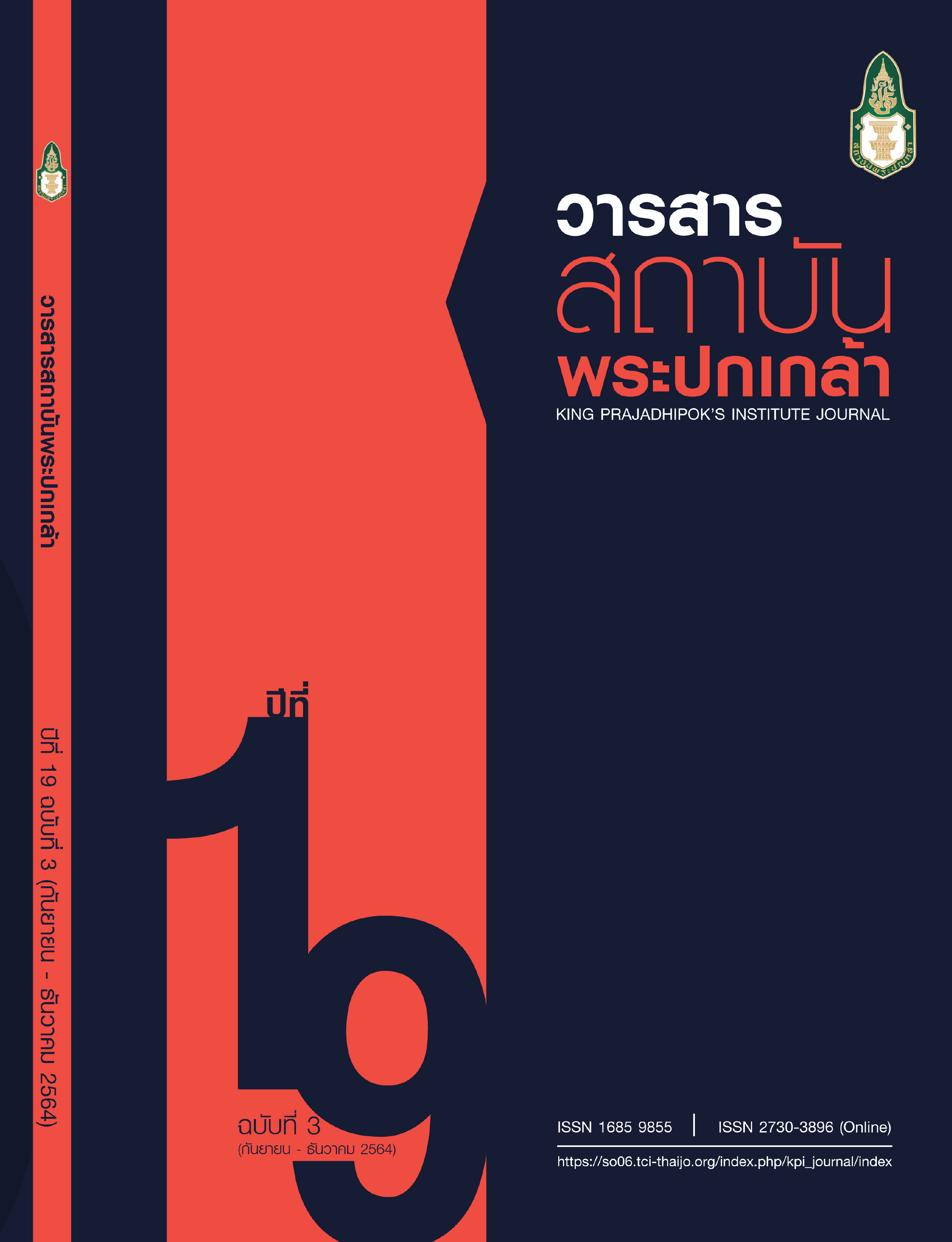Democracy Learning Management Process for Youth, Using Choi
Main Article Content
Abstract
The research aimed to 1) study and analyze the current situation of learning management about democracy and 2) create creative learning management by integrating arts and culture of folk songs (Choi) that are about democracy. It is qualitative research, and it was divided into 2 phases. The first phase was to study and analyze the current situation of learning management about democracy, gather information from interviews. The key informants were 1) social studies teachers 2) ninth grade students. The second phase was to create and do the experiment of creating creative learning management, gather information from interviews. The key informants were 1) folk song teachers 2) folk song artists 3) experts in folk song 4) experts in social science teaching 5) experts in study fields related to politics 6) political activists. The data was analyzed using qualitative analysis with analytic induction and divided the result accordingly to topics then validated by triangulation method. The creative learning management was used in a target group which were 42 ninth-grade students from Watthaichumpol municipality school. The information after the experiment was collected using
The research instruments were 1) in-depth interview and focus group 2) non-Participant Observation 3) participant observation 4) draft of creative learning management 5) plans for creative learning 6) democracy learning assessment.
The result were found that
1) The results of the current situation of learning management about democracy were found that 1) teachers focused on teaching in a narrative style and being a guiding force in teaching. 2. The students were listeners and followed only the instructions.. 3. There were a lot of unnecessary contents. 4) There were no activities in which students participated. 5. Teachers’ teaching media were not varied.
2) The result of creating and doing experiment of creative learning management by integrating arts and culture of folk songs (Choi) that are about democracy was found that, after facing problems of current teaching methods and interviewed experts to make a draft of the learning management and use it on target group, students had gained many as follow 1) students participated in working process and gave opinions 2) they understood the basic concept of democracy 3) they created presentation using knowledge about democracy learned from Choi with creativity and tangibility 4) student seemed interested in learning more about democracy.
Article Details

This work is licensed under a Creative Commons Attribution-NonCommercial-NoDerivatives 4.0 International License.
@ 2020 King Prajadhipok's Institute The Government Complex Commemorating All Right Reserved.
References
กระทรวงศึกษาธิการ. (2551). หลักสูตรแกนกลางการศึกษาขั้นพื้นฐาน พุทธศักราช 2551. กรุงเทพฯ :ชุมนุมสหกรณ์การเกษตรแห่งประเทศไทย.
กรมวิชาการ. (2534). ความคิดสร้างสรรค์หลักการทฤษฎี การเรียนการสอน การวัดผลประเมินผล. กรุงเทพฯ : กรมวิชาการ.
_________. (2539). การประเมินผลจากสภาพจริง (Authentic assessment). กรุงเทพฯ : กรมวิชาการกระทรวงศึกษาธิการ.
________. (2544). หลักสูตรการศึกษาขั้นพื้นฐาน. พิมพ์ครั้งที่ 2. กรุงเทพมหานคร : โรงพิมพ์องค์การรับส่งสินค้าและพัสดุภัณฑ์.
________. (2545). หลักสูตรการศึกษาขั้นพื้นฐาน พุทธศักราช 2544. กรุงเทพมหานคร : โรงพิมพ์องค์การรับส่งสินค้าและพัสดุภัณฑ์.
ชรินทร์ มั่งคั่ง. (2561). องค์ความรู้และการสอนสังคมศึกษา. พิมพ์ครั้งที่ 2. กรุงเทพฯ : สำนักพิมพ์แห่งจุฬาลงกรณ์มหาวิทยาลัย.
ดรุณี จำปาทอง. (2560, ก.ค.-ธ.ค.). สภาพการจัดการเรียนการสอนกลุ่มสาระการเรียนรู้สังคมศึกษา ศาสนา และวัฒนธรรมตามหลักสูตรแกนกลางการศึกษาขั้นพื้นฐาน พุทธศักราช 2551 ในระดับการศึกษาภาคบังคับ. วารสารศึกษาศาสตร์มหาวิทยาลัยสุโขทัยธรรมาธิราช, 10(2), 121.
ทิศนา แขมมณี. (2562). ศาสตร์การสอน : องค์ความรู้เพื่อการจัดกระบวนการเรียนรู้ที่มีประสิทธิภาพ. พิมพ์ครั้งที่ 23. กรุงเทพฯ : สำนักพิมพ์แห่งจุฬาลงกรณ์มหาวิทยาลัย.
__________. (2560). รูปแบบการเรียนการสอน : ทางเลือกที่หลากหลาย. พิมพ์ครั้งที่ 9. กรุงเทพฯ : สำนักพิมพ์แห่งจุฬาลงกรณ์มหาวิทยาลัย.
__________. (2560). 14 วิธีสอนสำหรับครูมืออาชีพ. พิมพ์ครั้งที่ 13. กรุงเทพฯ : สำนักพิมพ์แห่งจุฬาลงกรณ์มหาวิทยาลัย.
ประจักษ์ ปฏิทัศน์. (2562). การคิดเชิงระบบและความคิดสร้างสรรค์. กรุงเทพมหานคร : สำนักพิมพ์จุฬาลงกรณ์มหาวิทยาลัย.
ปิยะศักดิ์ สินทรัพย์. (2530). การศึกษาผลสัมฤทธิ์ทางการเรียน และความสนใจในวิชาภาษาไทย ของนักเรียนชั้นมัธยมศึกษาปี ที่ 2 ที่เรียนด้วยการใช้เกมและเพลงประกอบการสอน. (ปริญญานิพนธ์การศึกษามหาบัณฑิต กศ.ม.(การสอนมัธยม)) มหาวิทยาลัยศรีนครินทรวิโรฒ, สาขาวิชาการมัธยมศึกษา. กรุงเทพฯ : บัณฑิตวิทยาลัย.
พิทยา โพธิ์ทอง. (2549). การศึกษาผลสัมฤทธิ์ทางการเรียนและความพึงพอใจทางการเรียน เรื่องมาสร้างโลกสีเขียวกันเถอะ ของนักเรียนชั้นมัธยมศึกษาปีที่ 1 ที่เรียนโดยการใช้เกมและเพลงประกอบการสอน. (สารนิพนธ์ปริญญาการศึกษามหาบัณฑิต (กศ.ม.)) มหาวิทยาลัยศรีนครินทรวิโรฒ, สาขาวิชาการมัธยมศึกษา (การสอนสิ่งแวดล้อม). กรุงเทพฯ : บัณฑิตวิทยาลัย.
ไพฑูรย์ สินลารัตน์. (2560). การศึกษาไทย 4.0 : ปรัชญาการศึกษาเชิงสร้างสรรค์และผลิตภาพ. พิมพ์ครั้งที่ 4. กรุงเทพฯ : สำนักพิมพ์แห่งจุฬาลงกรณ์มหาวิทยาลัย.
ราชบัณฑิตยสถาน. (2529). พจนานุกรมไทยฉบับราชบัณฑิตยสถาน พุทธศักราช 2525. กรุงเทพฯ : อักษรเจริญทัศน์.
รณชัย โตสมภาค. (2560). ประชาธิปไตย. สืบค้น จาก http://www.kpi.ac.th/
วิริยะ ฤๅชัยพาณิชย์ และวรวรรณ นิมิตพงษ์กุล. (2562). สอนสร้างสรรค์ เรียนสนุกยุค 4.0+. พิมพ์ครั้งที่ 2. กรุงเทพฯ : ซีเอ็ดยูเคชั่น.
ศรีบังอร จุ้ยศิริ. (2550). การเปรียบเทียบผลสัมฤทธิ์ทางการเรียนและความสนใจในวิชา ภาษาไทย ของนักเรียนชั้นมัธยมศึกษาปีที่ 3 ที่เรียนวรรณคดีไทยโดยใช้เพลง ประกอบการสอนกับการสอนแบบปกติ. (สารนิพนธ์ปริญญาการศึกษามหาบัณฑิตสารนิพนธ์ (กศ.ม.)) มหาวิทยาลัยศรีนครินทรวิโรฒ, สาขาวิชาการมัธยมศึกษาบัณฑิตวิทยาลัย. กรุงเทพฯ : บัณฑิตวิทยาลัย.
ศรีอัมพร ประทุมนันท์. (2549). เพลงพื้นบ้านกับการสอนภาษาไทย. กรุงเทพฯ : ศรีเมืองการพิมพ์.
สังเวียน สฤษดิกุล. (2525). พฤติกรรมการสอนภาษาอังกฤษ 2. กรุงเทพฯ : มหาวิทยาลัยรามคำแหง.
สิริพัชร์ เจษฎาวิโรจน์. (2546). การจัดการเรียนการสอนแบบบูรณาการ. กรุงเทพฯ : บุ๊ค พอยท์.
________________. (2550). การสอนระดับประถมศึกษา 2. พิมพ์ครั้งที่ 2. กรุงเทพฯ : สำนักพิมพ์มหาวิทยาลัยรามคำแหง
สิริวรรณ ศรีพหล. (2560). การพัฒนาชุดฝึกอบรมทางไกลสำหรับครูสังคมศึกษา เรื่อง การพัฒนาการเรียนรู้มโนมติในกลุ่มสาระการเรียนรู้สังคมศึกษา ศาสนา และวัฒนธรรม. วารสารศึกษาศาสตร์มหาวิทยาลัยสุโขทัยธรรมาธิราช, 10 (1), 75.
สำนักวิชาการและมาตรฐานการศึกษา. (2559). คู่มือบริหารจัดการเวลาเรียนตามนโยบาย “ลดเวลาเรียน เพิ่มเวลารู้”. พิมพ์ครั้งที่1. กรุงเทพฯ : โรงพิมพ์ชุมนุมสหกรณ์การเกษตรแห่งประเทศไทย จำกัด.
เอนก นาวิกมูล. (2528). สารานุกรมเพลงพื้นบ้านภาคกลาง. กรุงเทพฯ : โรงพิมพ์พิฆเนศ
____________. (2550). เพลงนอกศตวรรษ. พิมพ์ครั้งที่ 4. กรุงเทพฯ : มติชน.
____________. (2550). เพลงพื้นบ้าน. กรุงเทพฯ : สำนักอุทยานการเรียนรู้.
ภาษาอังกฤษ
Anderson, Lorin W., David R. Krathwohl, et. al. (2001). A Taxonomy for Learning, Teaching, andAssessing : A Revision of Bloom’s Taxonomy of Educational Objectives. Abridged ed. New York : Longman.
Bloom, B. (1994). Reflection on the Development and Use of the Taxonomy. In Anderson, L. Sosniak, L (Eds.) Bloom’s Taxonomy : A Forty-Year Retrospective. Chicago : The National Society for the Study of Education
Bloom, B.S. (1965). Taxonomy of educational objective. Handbook II : Affective domain. New York : Mackay
Krathowhl, D. R. (2002). A Revision of Bloom’s Taxonomy : An Overview. Theory into Practice, 41(4) : pp.212-218


